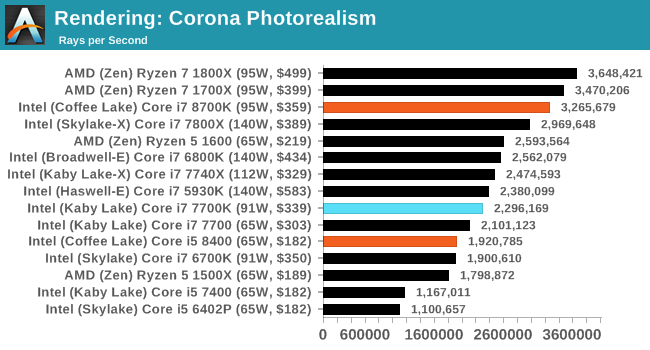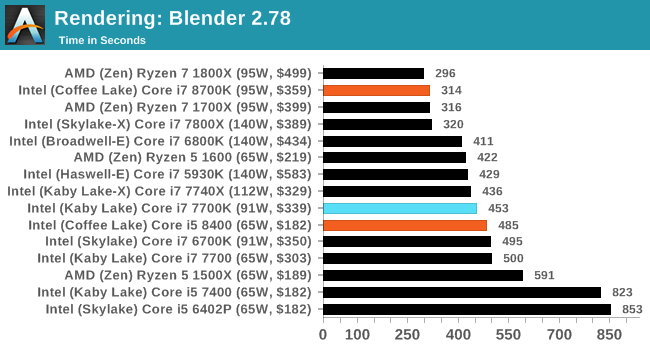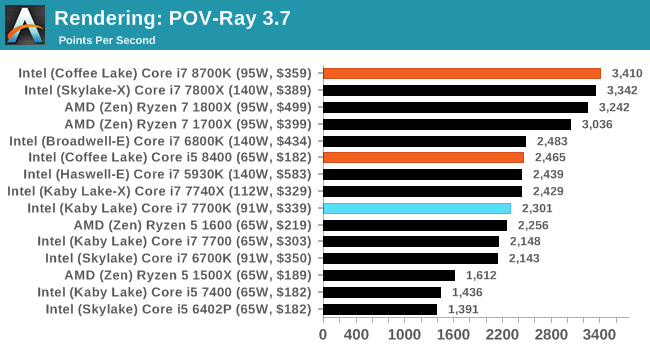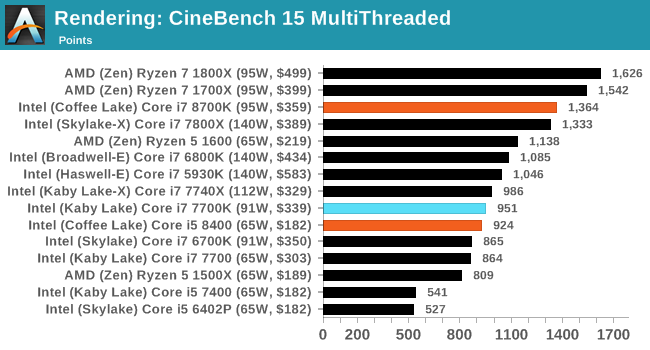The AnandTech Coffee Lake Review: Initial Numbers on the Core i7-8700K and Core i5-8400
by Ian Cutress on October 5, 2017 9:00 AM EST- Posted in
- CPUs
- Intel
- Core i5
- Core i7
- Core i3
- 14nm
- Coffee Lake
- 14++
- Hex-Core
- Hyperthreading
Benchmarking Performance: CPU Rendering Tests
Rendering tests are a long-time favorite of reviewers and benchmarkers, as the code used by rendering packages is usually highly optimized to squeeze every little bit of performance out. Sometimes rendering programs end up being heavily memory dependent as well - when you have that many threads flying about with a ton of data, having low latency memory can be key to everything. Here we take a few of the usual rendering packages under Windows 10, as well as a few new interesting benchmarks.
All of our benchmark results can also be found in our benchmark engine, Bench.
Corona 1.3: link
Corona is a standalone package designed to assist software like 3ds Max and Maya with photorealism via ray tracing. It's simple - shoot rays, get pixels. OK, it's more complicated than that, but the benchmark renders a fixed scene six times and offers results in terms of time and rays per second. The official benchmark tables list user submitted results in terms of time, however I feel rays per second is a better metric (in general, scores where higher is better seem to be easier to explain anyway). Corona likes to pile on the threads, so the results end up being very staggered based on thread count.

With more threads on display, the Core i7-8700K gets ahead of the previous mainstream Core i7 parts. The frequency difference over the Skylake-X processor gives an extra +10% performance, but the 16-thread parts from AMD win out overall.
Blender 2.78: link
For a render that has been around for what seems like ages, Blender is still a highly popular tool. We managed to wrap up a standard workload into the February 5 nightly build of Blender and measure the time it takes to render the first frame of the scene. Being one of the bigger open source tools out there, it means both AMD and Intel work actively to help improve the codebase, for better or for worse on their own/each other's microarchitecture.

Blender seems to separate very nicely into core counts, with six cores from Intel matching eight cores from AMD.
LuxMark v3.1: Link
As a synthetic, LuxMark might come across as somewhat arbitrary as a renderer, given that it's mainly used to test GPUs, but it does offer both an OpenCL and a standard C++ mode. In this instance, aside from seeing the comparison in each coding mode for cores and IPC, we also get to see the difference in performance moving from a C++ based code-stack to an OpenCL one with a CPU as the main host.

POV-Ray 3.7.1b4: link
Another regular benchmark in most suites, POV-Ray is another ray-tracer but has been around for many years. It just so happens that during the run up to AMD's Ryzen launch, the code base started to get active again with developers making changes to the code and pushing out updates. Our version and benchmarking started just before that was happening, but given time we will see where the POV-Ray code ends up and adjust in due course.

Cinebench R15: link
The latest version of CineBench has also become one of those 'used everywhere' benchmarks, particularly as an indicator of single thread performance. High IPC and high frequency gives performance in ST, whereas having good scaling and many cores is where the MT test wins out.


CineBench R15 in single thread mode can take the Core i7-8700K by the horns and drag it to be the best performing chip ever tested.










222 Comments
View All Comments
watzupken - Thursday, October 5, 2017 - link
I don't know how you define as "best" for review graph. The point is that we are seeing new 6 cores solution from Intel, so very logically, people will be trying to compare apples with apples, i.e. 6 core solutions from both camps. So omitting the results from 1600 actually looks more than meets the eye to me, especially when you folks previously did a R5 1600X review.Ian Cutress - Thursday, October 5, 2017 - link
I'm adding the R5 1600 data. It'll take 10-15 minutes, it's not a quick process. brbwatzupken - Thursday, October 5, 2017 - link
Thank you Ian. Please do add the data for R5 1600/X. From what I read elsewhere, it appears there is good competition between the Core i5 and R5 1600/X series.Ian Cutress - Thursday, October 5, 2017 - link
OK, should be added. You might have to CTRL+F5 to clear the cache to see the updated versions.WinterCharm - Thursday, October 5, 2017 - link
Thanks Ian!It really is the most logical and fair comparison.
WinterCharm - Thursday, October 5, 2017 - link
You really should have chosen SIMILARLY priced chips (So, 1700 / 1600 / 1600X) because it would have shown "here's the performance you get per dollar" which ultimately is what matters.Ian Cutress - Thursday, October 5, 2017 - link
My ultimate goal is to have a graph widget that lets you select which CPU you want to focus on, and it automatically pulls in several around that price point as well as some of the same family. I'm not that skilled, thoughError415 - Thursday, October 5, 2017 - link
Performane per dollar doesn't matter, out right performance matters. SMH, only a fool buys the second best cpu when the best is only a few dollars more.zuber - Thursday, October 5, 2017 - link
You basically just said "performance per dollar doesn't matter, only a fool ignores performance per dollar".sonny73n - Friday, October 6, 2017 - link
+1